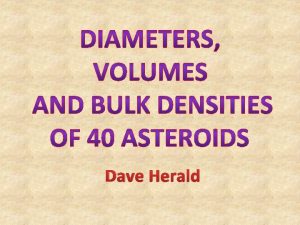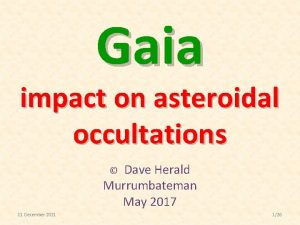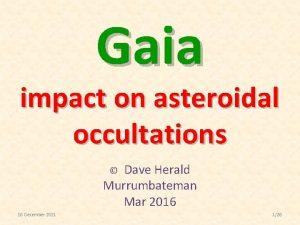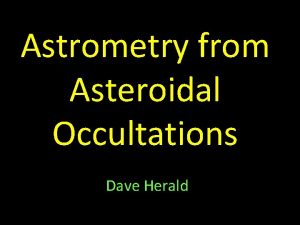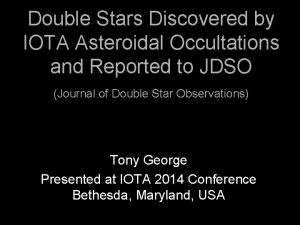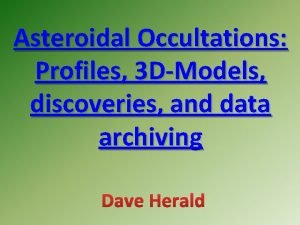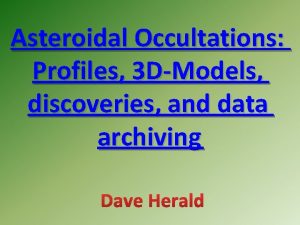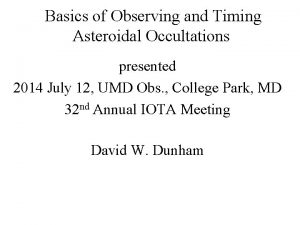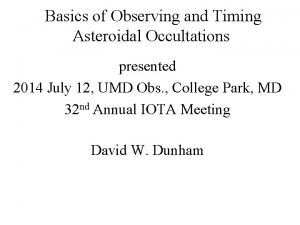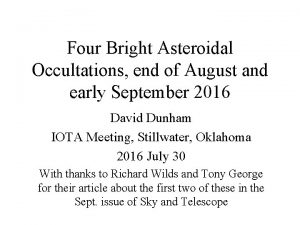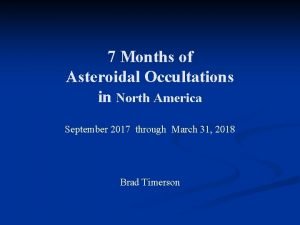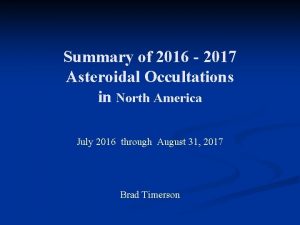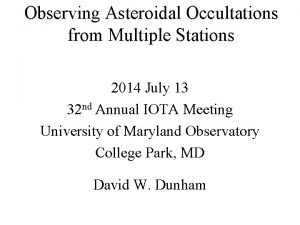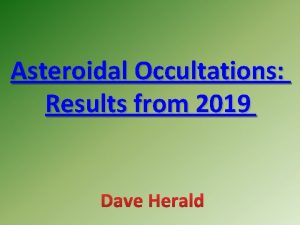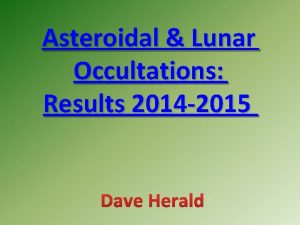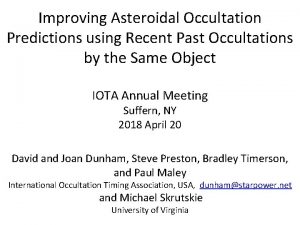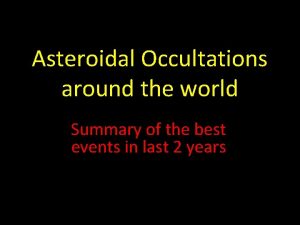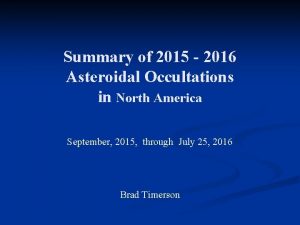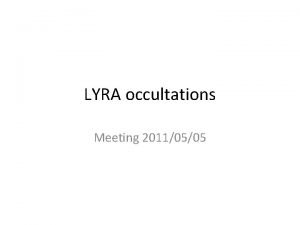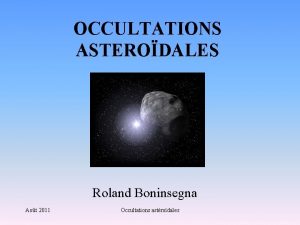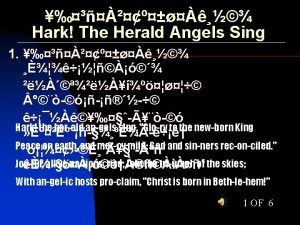Asteroidal Occultations and Shape Models Dave Herald The


























- Slides: 26

Asteroidal Occultations and Shape Models Dave Herald

The problem • An occultation gives an accurate profile of an asteroid for its orientation at the time of an event • Asteroids are irregular to greater or lesser extents => an accurate asteroid diameter can’t be determined from one or two occultations – only an approximate diameter

Asteroid Shape Models • A group of astronomers (largely ‘unpaid’ astronomers) measure the light curves of asteroids in different parts of their orbit • These light curves can be ‘inverted’ to derive the shape of the asteroid

(30) Urania Light curve measurements (Blue dots) and light curve from a model (Red line)

Shape model ‘issues’ • A shape model has no size – just shape • The inversion process usually results in two different orientations of the axis of rotation – with differing shapes. Inversion process cannot determine which one is correct • The inversion process is complex. Early models were limited to convex surfaces. Over the last few years models with concave surfaces have been developed • Inversion assumes uniform surface reflectivity

The two shape models for (30) Urania, with different rotational axes

Two shape models for (130) Electra one convex, and one concave, model

Determining asteroid diameters • Question: what is the ‘diameter’ of an irregular object like (216) Kleopatra, or a household brick? • For major planets, the ‘diameter’ (unqualified) is usually interpreted as the equatorial diameter • Asteroid diameters measured by IR satellites depend on reflection – which depends on surface area

Two important diameters • Volume-equivalent diameter – diameter of a sphere having the same volume. Associate this with the asteroid’s mass, and you get the asteroid’s density • Surface-equivalent diameter – diameter of a sphere having the same surface area. This relates to IR satellite measurements of diameter • [a tri-axial ellipsoid gives 3 dimensions, from which an approximate ‘diameter’ or volume can be derived]

Process to derive a diameter • Shape models fully account for the irregular shape of an asteroid (unlike triaxial ellipsoids) • The model includes data that gives the dimension of both the Volume-equivalent and Surface-equivalent diameters, on the scale of the projected image • Net result – when you match the occultation chords to the projected shape model image, you get a direct measurement of the diameters.

Fitting occultations to shape models • The next three slides show fits of the occultation of (90) Metis on 2008 Sept 12 to three shape models available for Metis, and the conclusions to be drawn. • The derived diameter is a ‘volume-equivalent’ diameter. • A ‘surface-equivalent’ diameter can also be derived.

• A fairly good fit to convex shape model derived in 2011 • Measured ‘volume-equivalent’ diameter 169 km

• A fit to a concave shape model derived in 2013 • The fit is clearly poor. Even so, the diameter can be assessed as being about 170 km

• Fit to a 2017 convex shape model • (note the smoother surface cf. 2013) • Derived diameter 167 km

Need to identify the correct model & deal with ‘odd’ observations [this example is (51) Nemausa] • • • Bottom chord looks to have ‘problems’ 1 st model reasonable. Dia = 144 km 2 nd model better. Dia = 146 km 3 rd model – clearly wrong No model is close to a perfect fit.

Diameter of (51) Nemausa using all events From these results Diameters from all events of Nemausa 2007 1979 2004 2016 2015 2018 2014 2005 2016 2017 2011 2015 2014 2017 2018 2002 1983 2006 2013 2014 2003 2007 Feb Aug Mar Jan Aug Sep Jan Feb Jul Jan Oct Mar Oct Sep Mar Jan 28, 17, 21, 1, 9, 14, 21, 3, 29, 4, 22, 12, 22, 31, 21, 11, 30, 8, 6, 3, min max 140, 141, 153, 0. 0, 0. 0, >128, 0, >116, 0, 144, 152, >120, 0, 148, 0, 0. 0, >152, 0, >131, 0, 147, 145, 146, 151, 154, 138, 140, 144, 149, 143, 145, 0°, 0°, 0°, 0°, 0°, 0°, 16°, Diameter but no fit 1 chords, Not fitted 3 chords, Not fitted 1 chords, Not fitted Minimum diameter Diameter but no fit Minimum diameter Model wrong 2 chords, Not fitted Minimum diameter Good fit Poor fit Good fit Occultation diameter Using only ‘good fit’ results 146. 5 ± 1. 4 km Using all measures 146. 0 ± 3. 8 km Compare with the satellite results IR satellite diameters NEOWISE Acu. A IRAS 146. 1 138. 1 158. 5 145. 4 147. 8 ± 81. 0 km km ± 15. 0 km ± 14. 0 km ± 4. 0 km

Rotation periods • In addition to diameters, occultations can be used to improve rotation periods • A particular example is the binary asteroid (90) Antiope Small-aperture occultation resolution is HUGELY better than the largest optical telescopes Adaptive optics image from the 10 -m Keck telescope

3 Good Antiope events 2008 Jan 2 2011 Jul 19 2015 Apr 2 • All models centered on the same component (happens to be the upper one). The plots show that the other component is not aligned – and by varying amounts. • Implies a change in the phase angle at the zero reference time, or possible change in period • By varying the shape-model phase for each event, we can determine a correction to the rotation period

Analysis of Antiope rotation period • • 2008 Jan 2 -6°, 105 km Poor chord distribution on 2 nd component • 2011 Jul 19 -2°, 100 km • 2015 Apr 2 +4°, 99. 6 km Measured phase change 10° over 7. 25 yrs derived rotation correction = +0. 00378°/day Orbital period 16. 505046 hrs = 523. 47627°/day New rotation per day = 523. 4805 °/day New rotation period = 16. 504913 hrs. Phase change (deg) by year

High precision astrometry • Occultation astrometry is reported as an offset from the occulted star. • 99. 7% of occulted stars have Gaia DR 2 positions • For a well-observed occultation, the astrometric uncertainty can be as low as 0. 0001” – that is, 100 µ-arcsec [typical CCD astrometry using modest ‘scopes has an uncertainty of around 200 mas. ]

Limitations on CCD Astrometry • Traditional CCD astrometry measures the centre of light of an asteroid • Orbital motion is dictated by the location of the centre of mass, not the centre of light. • The center of light will differ from the center of mass because of: – Solar illumination phase – Differences between the location of centre of mass and the centre of figure Solar illuminated, phase affected True profile Black marker is centre of mass (assuming uniform density). The centre of figure is clearly located to the right of the marker.

Reporting astrometry from occultations • When a shape model is available, differences between the centre of figure and centre of mass become apparent • Whenever possible, we will be reporting astrometry derived from Occultations to the Minor Planet Center based on Center of Mass. However the IAU standard ADES needs to be updated to allow this to happen. • Extract of an astrometric report in ADES format…. perm. ID |prov. ID 6| 6| 6| 12| 15| 16| 18| 23| 25| 39| 50| |mode|stn|obs. Time |ra. Star |dec. Star |delta. RA |delta. Dec|rms. RA |rms. Dec|ast. Cat |com| |OCC |244|2019 -01 -01 T 15: 23. 85 Z| 94. 57830780| 5. 98653780| 3. 7771| -5. 0411|0. 0084|0. 0158| GDR 2|0 | |OCC |244|2019 -01 -14 T 03: 50: 36. 88 Z| 91. 68994530| 7. 90771260| 0. 4213| 3. 8808|0. 0003| GDR 2|0 | |OCC |244|2019 -02 -04 T 11: 59: 15. 35 Z| 89. 13044205| 11. 53498680| -0. 0918| 2. 2475|0. 0907| GDR 2|0 | |OCC |244|2019 -01 -17 T 22: 00: 52. 75 Z| 51. 00970935| 15. 25879300| 2. 1970| 2. 3123|0. 0426| GDR 2|0 | |OCC |244|2019 -04 -27 T 17: 18: 33. 15 Z|318. 28846875|-15. 95389700| -1. 9653| -1. 2354|0. 0018|0. 0025| GDR 2|0 | |OCC |244|2019 -02 -08 T 13: 12: 17. 29 Z|288. 16164090|-20. 41309960| -1. 7603| 1. 5196|0. 0035|0. 0285| GDR 2|0 | |OCC |244|2019 -06 -26 T 06: 13: 20. 06 Z|280. 95155790| -8. 63512850| -2. 0251| 4. 6716|0. 0102|0. 0413| GDR 2|0 | |OCC |244|2019 -01 -11 T 22: 53: 27. 29 Z| 28. 93467885| 9. 17252450| 3. 1163| 2. 6017|0. 0369| GDR 2|0 | |OCC |244|2019 -01 -17 T 18: 17: 19. 50 Z| 93. 66505440| -5. 60617100| 3. 3456| 2. 4467|0. 0190|0. 0722| GDR 2|0 | |OCC |244|2019 -03 -07 T 17: 40: 55. 49 Z|301. 17339015|-13. 46387930| -2. 1839| -1. 4195|0. 0033|0. 0153| GDR 2|0 | |OCC |244|2019 -04 -01 T 22: 36: 33. 20 Z|172. 62366960| 3. 49482950| 0. 4524| 2. 6472|0. 0010|0. 0008| GDR 2|0 | |OCC |244|2019 -06 -25 T 12: 47: 19. 38 Z|172. 91053110| 3. 87288430| 1. 9023| 1. 4413|0. 0000| GDR 2|0 |

Occultations to support space missions • We all know about Ultima Thule & New Horizons…. • Japan will be launching DESTINY+ in 2022 to explore (3200) Phaethon – the Apollo asteroid responsible for the Geminid meteor stream • JAXA keen to get precise position of the asteroid, and measure of its size • IR satellite measures: Acu. A 4. 8 km IRAS 5. 1 km

(3200) Phaethon outcomes • Successfully observed in the US on 29 July • Event tested the accuracy of prediction software of all • Gravitational deflection of the light by the Sun was similar to the width of the occultation path • Event provided a unique opportunity to compare and improve prediction software • Unfortunately a subsequent event on Aug 21 in Japan was clouded out.

Phaethon - preliminary results Ellipse 5. 7 x 4. 7 km Diamater is larger than Acu. A and IRAS by ~ 5% Fit to an unpublished shape model

Questions?
 Dave herald
Dave herald Othello act 2
Othello act 2 Silver knight award requirements
Silver knight award requirements Mystical communion model of the church
Mystical communion model of the church 天使報信
天使報信 Harold the herald angels sing
Harold the herald angels sing Praise be to you my lord
Praise be to you my lord Mentor character archetype examples
Mentor character archetype examples Haven vs wilderness archetype examples
Haven vs wilderness archetype examples Threshold guardian archetype examples
Threshold guardian archetype examples Yakima herald republic circulation
Yakima herald republic circulation Herald archetype examples
Herald archetype examples Pete rosengren daily herald
Pete rosengren daily herald Modal and semi modal verbs
Modal and semi modal verbs Shape matching and object recognition using shape contexts
Shape matching and object recognition using shape contexts Template matching
Template matching Cessna airfoil
Cessna airfoil Hình ảnh bộ gõ cơ thể búng tay
Hình ảnh bộ gõ cơ thể búng tay Lp html
Lp html Bổ thể
Bổ thể Tỉ lệ cơ thể trẻ em
Tỉ lệ cơ thể trẻ em Voi kéo gỗ như thế nào
Voi kéo gỗ như thế nào Chụp phim tư thế worms-breton
Chụp phim tư thế worms-breton Chúa yêu trần thế alleluia
Chúa yêu trần thế alleluia Môn thể thao bắt đầu bằng từ chạy
Môn thể thao bắt đầu bằng từ chạy Thế nào là hệ số cao nhất
Thế nào là hệ số cao nhất Các châu lục và đại dương trên thế giới
Các châu lục và đại dương trên thế giới
